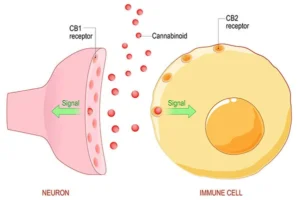Discover the therapeutic potential of cannabinoids, focusing on the benefits of THC, CBD, and other lesser-known compounds. Explore how these substances are shaping the future of cannabis-based therapies.
Introduction:
Cannabis has been at the center of medical research and public interest in recent years, largely due to the discovery of its numerous cannabinoids and their potential therapeutic applications. With over 100 different cannabinoids identified to date, each with its unique properties and potential benefits, the world of cannabis is far more complex than most people realize. In this article, we’ll delve into the differences between the two most well-known cannabinoids, THC and CBD, and explore the lesser-known but equally fascinating compounds that are shaping the future of cannabis-based therapies.
THC and CBD: The Power Couple of Cannabis

THC (tetrahydrocannabinol) and CBD (cannabidiol) are the two most abundant and well-studied cannabinoids found in the cannabis plant. THC is the primary psychoactive compound responsible for the “high” associated with cannabis use. It works by binding to the CB1 receptors in the brain, which are involved in regulating mood, memory, appetite, and pain perception. In addition to its recreational use, THC has been shown to have potential therapeutic benefits, such as pain relief, appetite stimulation, and mood elevation, making it a valuable tool in managing conditions like chronic pain, anorexia, and depression.
CBD, on the other hand, is non-intoxicating and has gained significant popularity in recent years for its wide range of potential health benefits. Unlike THC, CBD does not bind directly to the CB1 receptors in the brain, but rather interacts with the body’s endocannabinoid system indirectly, modulating the effects of other cannabinoids and neurotransmitters. CBD has been shown to have anti-inflammatory, anxiolytic (anti-anxiety), and anticonvulsant properties, making it a promising treatment option for conditions like arthritis, anxiety disorders, and epilepsy. In fact, the FDA has already approved a CBD-based medication called Epidiolex for the treatment of severe forms of epilepsy.
The Entourage Effect: How Cannabinoids Work Together

While THC and CBD are the most well-known cannabinoids, they are far from the only ones that matter. The cannabis plant contains numerous other cannabinoids, terpenes (aromatic compounds), and flavonoids that work synergistically to produce what is known as the entourage effect. This phenomenon refers to the enhanced therapeutic potential of cannabinoids when they are consumed together, rather than in isolation. For example, studies have shown that the presence of certain terpenes can enhance the pain-relieving effects of THC, while the combination of THC and CBD can mitigate some of the negative side effects associated with THC use, such as anxiety and paranoia.
Lesser-Known Cannabinoids: The Next Frontier in Cannabis Research

While THC and CBD have dominated the cannabis research landscape, many other cannabinoids are garnering attention for their unique properties and potential therapeutic applications. Some of the most promising lesser-known cannabinoids include:
- CBG (Cannabigerol): Often referred to as the “mother cannabinoid,” CBG is the precursor to THC, CBD, and CBC. It has been shown to have potential antibacterial, anti-inflammatory, and neuroprotective properties, making it a promising target for treating conditions like glaucoma, inflammatory bowel disease, and Huntington’s disease. Learn more about CBG.
- CBC (Cannabichromene): CBC is a non-psychoactive cannabinoid that has been shown to have potential anti-inflammatory, analgesic (pain-relieving), and anti-tumor properties. It may also positively affect brain function, promoting neurogenesis (the growth of new brain cells) and protecting against neurodegenerative diseases like Alzheimer’s. Read about CBC here.
- CBN (Cannabinol): CBN is a mildly psychoactive cannabinoid formed when THC is exposed to air and light over time. It has been shown to have potential sedative and anti-inflammatory effects, making it a promising treatment option for conditions like insomnia and arthritis. Discover the benefits of CBN.
As research into these lesser-known cannabinoids continues, we will likely discover even more potential therapeutic applications for these fascinating compounds.
The Future of Cannabinoid-Based Therapies

The discovery of the endocannabinoid system and the numerous cannabinoids found in the cannabis plant has opened up a whole new world of possibilities for developing novel therapies for a wide range of conditions. As our understanding of these compounds continues to grow, we can expect to see an increasing number of cannabinoid-based medications hitting the market in the coming years.
One of the most exciting areas of cannabinoid research is the development of synthetic cannabinoids and cannabinoid analogs. These compounds are designed to mimic the effects of natural cannabinoids while minimizing potential side effects and improving bioavailability. Some examples of synthetic cannabinoids currently being investigated for their therapeutic potential include:
- Dronabinol: A synthetic form of THC that is approved by the FDA for treating chemotherapy-induced nausea and vomiting, as well as appetite stimulation in patients with AIDS.
- Nabilone: Another synthetic THC analog that is approved for treating chemotherapy-induced nausea and vomiting.
- HU-308: A synthetic CB2 receptor agonist that has been shown to have potential anti-inflammatory and analgesic effects without the psychoactive side effects associated with THC.
As research into cannabinoids continues to advance, we can expect to see an increasing number of these compounds being developed and tested for their therapeutic potential.
Final Thoughts: A Bright Future for Cannabinoid-Based Therapies
The world of cannabinoids is a fascinating and rapidly evolving field that holds immense promise for developing novel therapies for a wide range of conditions. From the well-known power couple of THC and CBD to the lesser-known but equally intriguing compounds like CBG, CBC, and CBN, the cannabis plant contains a wealth of potential therapeutic agents that are just waiting to be discovered and harnessed.
As our understanding of the endocannabinoid system and the complex interplay between cannabinoids continues to grow, we can expect to see an increasing number of cannabinoid-based medications and therapies hitting the market in the coming years. With the potential to treat everything from chronic pain and inflammation to anxiety, depression, and neurodegenerative diseases, the future of cannabinoid-based therapies is truly exciting.
So, whether you are a patient seeking alternative treatment options, a researcher looking to uncover the next big breakthrough in cannabis science, or simply a curious individual fascinated by the complexities of this ancient plant, one thing is clear: the world of cannabinoids is one that is well worth exploring.



